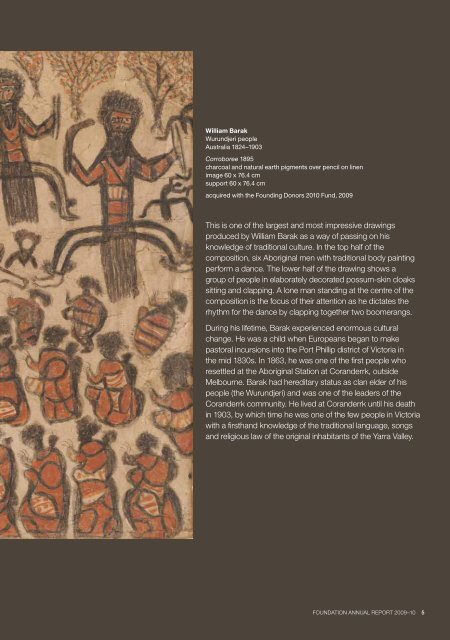foundation annual report 2009â10 - National Gallery of Australia
foundation annual report 2009â10 - National Gallery of Australia
foundation annual report 2009â10 - National Gallery of Australia
Create successful ePaper yourself
Turn your PDF publications into a flip-book with our unique Google optimized e-Paper software.
William Barak<br />
Wurundjeri people<br />
<strong>Australia</strong> 1824–1903<br />
Corroboree 1895<br />
charcoal and natural earth pigments over pencil on linen<br />
image 60 x 76.4 cm<br />
support 60 x 76.4 cm<br />
acquired with the Founding Donors 2010 Fund, 2009<br />
This is one <strong>of</strong> the largest and most impressive drawings<br />
produced by William Barak as a way <strong>of</strong> passing on his<br />
knowledge <strong>of</strong> traditional culture. In the top half <strong>of</strong> the<br />
composition, six Aboriginal men with traditional body painting<br />
perform a dance. The lower half <strong>of</strong> the drawing shows a<br />
group <strong>of</strong> people in elaborately decorated possum-skin cloaks<br />
sitting and clapping. A lone man standing at the centre <strong>of</strong> the<br />
composition is the focus <strong>of</strong> their attention as he dictates the<br />
rhythm for the dance by clapping together two boomerangs.<br />
During his lifetime, Barak experienced enormous cultural<br />
change. He was a child when Europeans began to make<br />
pastoral incursions into the Port Phillip district <strong>of</strong> Victoria in<br />
the mid 1830s. In 1863, he was one <strong>of</strong> the first people who<br />
resettled at the Aboriginal Station at Coranderrk, outside<br />
Melbourne. Barak had hereditary status as clan elder <strong>of</strong> his<br />
people (the Wurundjeri) and was one <strong>of</strong> the leaders <strong>of</strong> the<br />
Coranderrk community. He lived at Coranderrk until his death<br />
in 1903, by which time he was one <strong>of</strong> the few people in Victoria<br />
with a firsthand knowledge <strong>of</strong> the traditional language, songs<br />
and religious law <strong>of</strong> the original inhabitants <strong>of</strong> the Yarra Valley.<br />
FOUNDATION ANNUAL REPORT 2009–10 5
















